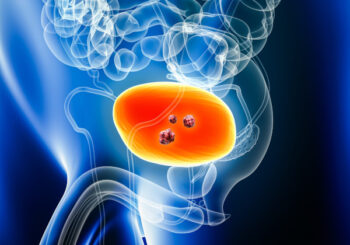Guest Writers for Wake Up World
Bladder cancer is one of the most common cancers in the U.S. In men, it’s the fourth most commonly diagnosed cancer, although it occurs much less frequently in women. The American Cancer Society estimates that in 2018 there were over 81,000 new cases of bladder cancer diagnosed (62,380 in men and 18,810 in women) and around 17,000 deaths from this disease (12,520 in men and 4,720 in women).
[pro_ad_display_adzone id=”110028″]
Bladder cancer typically afflicts older people. Roughly 9 out of 10 individuals who develop this disease are over the age of 55, while the average age at the time of diagnosis is 73 years. The chance that an American man will develop this cancer during his lifetime is about 1 in 27. For an American woman, the risk is much lower, at about 1 in 89. Generally speaking, Caucasians are more likely to be afflicted with bladder cancer than African Americans or Hispanic Americans.
Fortunately, 50% of all cases of bladder cancers are detected early, while they are still confined to the inner layer of the bladder wall. A third will have invaded into deeper layers but will still only be in the bladder. In most of the remaining cases, bladder cancer cells will have spread to nearby tissues or lymph nodes outside the bladder. Very rarely, in about four percent of bladder cancer cases, it is likely to have metastasized, or spread to distant parts of the body.
The Role of the Urinary Bladder
The urinary bladder is a hollow, balloon-shaped organ with flexible, muscular walls situated in the pelvis in the lower part of our abdomen. Your bladder’s main job is to store urine made by the kidneys, your body’s natural blood filters. The kidneys work to control the amount of water and other substances dissolved in your body’s fluids by filtering excess fluid and waste products out of your blood. These waste products may include extra food components that your body doesn’t need and can’t store, as well as toxic compounds made in your body’s cells during their daily metabolic activities.
Typically, urine contains urea, creatinine, and electrolytes such as sodium, potassium, calcium, chloride and bicarbonate, along with water. As urine is made, it is sent into each kidney’s collecting tubules and exits into the urinary bladder through a long tube called a ureter. The bladder stores the urine until it is full, or nearly full, and is then forced out through the urethra and out of the body.
What Is Bladder Cancer?
Bladder cancer develops when different types of cells in the bladder start to grow uncontrollably. Depending on the cell affected, three types of cancer can occur in the cells lining the bladder:
Transitional cell carcinoma – this most common form of bladder cancer begins in the innermost tissue layer, which contains urothelial cells – hence also known as urothelial carcinoma. Urothelial cells are known as transitional cells because they can change their shape, stretching when the bladder is full and shrinking when it’s empty. Most bladder cancers begin in transitional cells.
Transitional cell carcinoma can either be low-grade or high-grade:
- Low-grade – this form can recur after treatment, but rarely spreads.
- High-grade – this form usually recurs after treatment and often spreads into the muscle layer of the bladder, to other parts of the body, and to lymph nodes when it becomes known as invasive bladder cancer. Almost all deaths from bladder cancer are due to high-grade disease.
Squamous cell carcinoma – these cancers begin after long-term infections or irritation in thin, flat cells lining the bladder, known as squamous cells.
Adenocarcinoma – these very rare cancers begin in the glandular cells that are found in the lining of the bladder, which make mucus.
Bladder cancer can also spread to other parts of the body and form tumors elsewhere – known as metastatic tumors – in one of three ways. Bladder cancer can spread from where it began by directly growing into nearby tissues. Alternatively, it can get into the lymphatic system and move to other parts of the body. Finally, it can enter the bloodstream and travel to distant parts of the body via the blood vessels. Such a metastatic tumor growing anywhere else in the body would still be bladder cancer. For example, if bladder cancer cells spread to bone and formed a tumor there, it would be called metastatic bladder cancer in the bone.
Common Signs of Bladder Cancer
Not surprisingly, the common signs of bladder cancer primarily have to do with urination. This can include:
- visible blood in the urine
- irritation or pain during urination
- frequent urination, particularly through the night
- urinary urgency (an inability to hold the urine for long after first feeling the need to go)
- feeling a strong need to urinate, but not being able to go
Other signs to watch out for include pelvic or back pain, including low back pain on only one side of the body.
Risk Factors for Bladder Cancer: Why Should You Know About Them?
A risk factor is anything that increases your chances of contracting or developing a disease; for example Alzheimer’s disease or cancer. Different diseases have different risk factors. Some risk factors (like smoking) can be changed, while other factors such as race, age, or family history, obviously cannot be mitigated.
Having one or more risk factors simply means that your chance of developing a particular disease is greater than the average – but it’s very important to remember that this doesn’t automatically mean you will get the disease. For example, many people with one or more of the risk factors for bladder cancer described below will never end up with bladder cancer.
Still, it’s important to be aware of these risk factors, and take action where possible to maximize your odds of staying healthy. Also, if you feel that you are at higher risk of getting bladder cancer, you can get yourself tested so that bladder cancer (if present), can be detected early, when intervention is most likely to be effective.
Let’s take a closer look at some of the known risk factors for bladder cancer.
Bladder Cancer Risk Factors That Can Be Controlled
Smoking cigarettes – this is a strong risk factor for bladder cancer. In both men and women, smoking causes about half of all bladder cancers. When compared to people who have never smoked, former and current smokers – both men and women – have a higher risk of getting bladder cancer. Stopping smoking immediately lowers risk, although risk for smokers remains higher than nonsmokers even if they had quit 10 years prior.
Pipe and cigar use is also linked to a greater risk of bladder cancer in men. Overall, men have nearly four times the risk of women for developing this disease, regardless of whether they smoked or not. Also, the composition of cigarettes has changed over the past 50 years, so that they now contain higher levels of cancer-causing compounds such as beta-napthylamine – a known bladder carcinogen – and nitrosamines. In fact, a recent report from the New England Bladder Study suggests that even though the total number of smokers in the U.S. has declined, smoking cigarettes may be more strongly linked to bladder cancer risk than ever before.
Workplace exposures – certain industrial chemicals have been linked to a greater risk of developing bladder cancer. So-called “aromatic amines” such as benzidine and beta-naphthylamine, which are used in the dye industry, are known to cause bladder cancer. It is estimated that occupational exposures to aromatic amines might explain up to a quarter of all cases of bladder cancer in and around areas with industries which still use these compounds.
The higher than average risk was still apparent 30 years or more after the last known exposure. Similarly, people who work with metalworking fluids – such as sheet metalworkers and machine operators – have a significantly higher risk of bladder cancer, which increases with duration of employment. Other industries that carry a high risk of bladder cancer include rubber, leather, textiles, paint products, and printing companies. Painters, machinists, printers, hairdressers, and truck drivers all have a greater than average risk of getting bladder cancer.
The evidence also indicates that aromatic amines may be responsible for the higher risk of bladder cancer in smokers as well. So, it makes sense that smokers who work with cancer-causing chemicals have an especially high risk of getting bladder cancer.
Diabetes – In a 2017 meta-analysis of 21 cohort studies, diabetes was clearly linked to an increased risk of bladder cancer and bladder cancer deaths, when compared with non-diabetic participants. Obviously, diabetes combined with smoking and workplace exposure to toxic chemicals is likely to drastically worsen this risk.
Pioglitazone – As mentioned above, people with diabetes are at increased risk of bladder cancer. According to the U.S. Food and Drug Administration (FDA), pioglitazone (brand name Actos), an anti-diabetic drug, increases bladder cancer risk further. However, a recent meta-analysis suggests that there is no link between use of pioglitazone and the risk of bladder cancer.
Aristolochic acids – these are natural compounds present in plants known as Aristolochia, which are used in some herbal medicinal products. Unfortunately, cancers of the upper urinary tract and bladder have been reported in some individuals who had kidney damage caused by consuming herbal products containing aristolochic acids.
Arsenic in drinking water – A 2016 study, carried out by researchers at the National Cancer Institute (NCI) and their colleagues at the Geisel School of Medicine at Dartmouth, as well as the departments of health for Maine, New Hampshire, and Vermont and the U.S. Geological Survey, has found that drinking water from private wells, especially dug wells established during the first half of the 20th century, may have contributed to the greater than average risk of bladder cancer seen in Maine, New Hampshire, and Vermont. These wells are believed to contain low to moderate levels of arsenic. Previous studies have shown that consumption of water containing high concentrations of arsenic increases the risk of bladder cancer.
Not drinking enough fluids – people who drink a lot of fluids, especially water, tend to have lower rates of bladder cancer. This might be because they empty their bladders more often, which likely keeps harmful chemicals from lingering in their bladder.
Chemotherapy – taking the chemotherapy drug cyclophosphamide (Cytoxan) for a long time can irritate the bladder and increase the risk of bladder cancer – which is why patients are usually given the lowest possible effective dose of this drug, told to drink plenty of fluids, and carefully monitored for the presence of blood and blood cells in their urine.
Radiation therapy – people treated with radiation to the pelvis are more likely to later develop bladder cancer.
[pro_ad_display_adzone id=”110030″]
Other Bladder Cancer Risk Factors
Race and ethnicity – As mentioned earlier, Caucasians in the U.S. are about twice as likely to develop bladder cancer as African Americans and Hispanic Americans. Asian Americans and American Indians have slightly lower rates of bladder cancer. The reasons for these racial and ethnic differences are not yet clear.
Age – the risk of bladder cancer increases with age, with 90% of bladder cancer found in those over age 55.
Gender – for as yet unknown reasons, bladder cancer is much more common in men than in women.
Chronic bladder irritation and infections – urinary infections, kidney and bladder stones, and bladder catheters that have been left in place too long have been linked with a greater risk of getting bladder cancer, although it’s not clear if they actually cause bladder cancer.
Schistosomiasis – this is an infection with a parasitic worm that can get into the bladder. Bladder cancers are common in countries where this parasite is common, mainly in Africa and the Middle East. Schistosomiasis and schistosomiasis-associated bladder cancer are uncommon in the U.S.
Personal history – having a cancer in the lining of any part of the urinary tract raises the risk of getting another cancer – either in the same area, or in another part of the urinary tract. This is true even when the first tumor is removed completely. For this reason, people who have already experienced one episode of bladder cancer need to remain vigilant and follow an anti-cancer lifestyle.
Family history – having family members with bladder cancer increases bladder cancer risk. This may be because members of the same family are sometimes exposed to the same cancer-causing chemicals. Alternatively, family members may also share genetic alterations or defects that make it difficult for their bodies to break down toxins, which can make it more likely that they develop bladder cancer.
Gene mutations – mutations in the telomerase reverse transcriptase (TERT), transforming protein 21 (HRas), tumor protein 53 (TP53), and retinoblastoma (RB1) genes can increase the risk of developing bladder cancer. All of these genes play an important role in managing cell division, which normally prevents cells in the body from dividing too quickly. Mutations in these managing genes makes it easier for cancer cells to form.
4 Steps to Lower Your Odds of Ever Getting Bladder Cancer
Don’t smoke – as we saw earlier, smoking cigarettes, cigars, and pipes is believed to be responsible for up to 50% of all bladder cancer cases – and stopping smoking immediately lowers bladder cancer risk. Lowering your risk of both lung and bladder cancer are excellent reasons to quit smoking immediately.
Limit exposure to chemicals, especially aromatic amines, in the workplace – workers in industries such as rubber, leather, printing materials, textiles, metalworking, and paint who use chemicals like aromatic amines and metalworking fluids run a greater risk of developing bladder cancer. The best way to minimize your exposure to such chemicals is to carefully follow good work safety practices. Regular exposure to diesel fumes might also raise bladder cancer risk, along with the risk of getting other cancers – so, limiting this exposure is also a good idea.
Drink plenty of liquids – studies in animals have shown that frequent urination lowers the levels of potential carcinogens in the urothelial layer of the bladder. Similarly, in us humans, drinking more fluids (especially water) is likely to reduce contact between potential carcinogens and the bladder lining by diluting waste products in the urine and frequent voiding of the bladder.
Drink green tea and eat a healthy diet with lots of fresh, locally grown, non-irradiated, non-GMO fruits & vegetables – studies looking for strong connections between dietary factors and bladder cancer risk have reported inconsistent results. This is likely because of lack of details of how foods including fruits and vegetables were consumed, smoking status, and other information. Some evidence suggests that excessive consumption of processed meat may increase bladder cancer risk, while tea polyphenols, vitamin A and carotenoids appear to lower risk.
Green tea polyphenols such as the catechins epigallocatechin-3-gallate (EGCG) and epigallocatechin (ECG) have been shown to have antioxidant and anti-inflammatory actions in multiple laboratory, animal, and human studies. Further, a diet rich in fruits, and especially vegetables, has been shown to have protective effects against cancer in general – and is most likely one of your very best protectants against bladder cancer as well.
Originally published at The Truth About Cancer and reproduced here with permission.
About the author:
 Ty Bollinger is a health freedom advocate, cancer researcher, former competitive bodybuilder and author. After losing several family members to cancer, he refused to accept the notion that chemotherapy, radiation, and surgery were the most effective treatments available for cancer patients. He began a quest to learn all he possibly could about alternative cancer treatments and the medical industry. What he uncovered was shocking. There is ample evidence to support the allegation that the “war on cancer” is largely a fraud and that multinational pharmaceutical companies are “running the show.” Ty has now made it his life mission to share the most remarkable discovery he made on his quest: the vast majority of all diseases, including cancer, can be easily prevented and even cured without drugs or surgery.
Ty Bollinger is a health freedom advocate, cancer researcher, former competitive bodybuilder and author. After losing several family members to cancer, he refused to accept the notion that chemotherapy, radiation, and surgery were the most effective treatments available for cancer patients. He began a quest to learn all he possibly could about alternative cancer treatments and the medical industry. What he uncovered was shocking. There is ample evidence to support the allegation that the “war on cancer” is largely a fraud and that multinational pharmaceutical companies are “running the show.” Ty has now made it his life mission to share the most remarkable discovery he made on his quest: the vast majority of all diseases, including cancer, can be easily prevented and even cured without drugs or surgery.
For more information, visit:
[pro_ad_display_adzone id=”110027″]







